Cavitation
October 16, 2017
We think of
liquids and
gases as being
soft materials, far too soft to damage anything as hard as
steel. I discovered that this is not always the case when I was asked to design a
sensor to detect the onset of
cavitation in an
hydraulic pump.
Mechanical action on a liquid can create
bubbles through a rapid decrease in
pressure. When this is followed by a a rapid change to higher pressure, these bubble will
implode to generate an intense
shock wave.
While the
impact from a bubble might not be enough to dislodge material from a
metal, all metals are subject to
cyclic fatigue damage in which repeated pulling and pushing (
tension and
compression) weakens the material. Cavitation damage can be seen in
ship propeller blades (see figure),
pump impellers, and
pipe bends that cause sudden change in the direction of rapidly moving liquid.
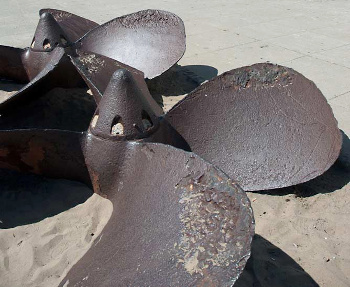
Cavitation damage on a ship propeller.
(US National Park Service photo)
Although the term, "cavitation," wasn't used, the
phenomenon was first mentioned by
Leonhard Euler (1707-1783) in his 1754 paper, "Théorie plus complette des machines qui sont mises en mouvement par la réaction de l'eau (A more complete theory of machines that are set in motion by reaction with water).[1] The term, "cavitation," was coined by R. E. Froude and first used by Barnaby and Thornycroft in 1893.[2] Barnaby and Parsons discovered that cavitation was responsible for the propeller failure of the
British warship,
HMS Daring. Parsons built a water version of a
wind tunnel in 1895 to assess cavitation damage.[2]
The
physics of cavitation was investigated by
Rayleigh, who analyzed the collapse of a void in a large liquid mass in 1917.[3] The
Rayleigh–Plesset equation, which is an
ordinary differential equation describing the
dynamics of cavitation, makes the simplifying assumption that the void is
spherical. The voids are actually more like
hemispheres, since they need to be
nucleated on a
surface.
Mechanical action is not the only way to create cavitation. Creating a
transient local
heating in the liquid, as by a
focused laser pulse or an
electrical discharge, will create a bubble. During bubble collapse, the
temperature and
pressure of the
gases in the bubble soar to extremes, with temperatures often rising to thousands of
kelvins, and pressure approaching hundreds of
atmospheres. Cavitation can cause
sonoluminescence (see figure).
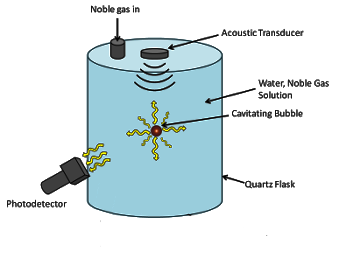
A bubble acoustically created in a noble gas saturated liquid will produce light during cavitation collapse. It's believed that the high temperature of the gas inside the collapsing bubble excites the gas to cause light emission.
Wikimedia Commons image (simplified) by Aolzick.
A spectacular demonstration of cavitation is found in the many
YouTube videos of the "breaking (beer) bottle trick" in which sharply striking the top of the
bottle breaks its bottom. Now a team of
scientists from
Utah State University (Logan, Utah), the
Tokyo University of Agriculture and Technology (Tokyo, Japan), the
Naval Undersea Warfare Center (Newport, Rhode Island), and
Brigham Young University (Provo, Utah) has done a detailed analysis of the cavitation system of the breaking bottle to develop an
equation that more accurately predicts cavitation.[4-5] Their
experimental results are presented in an article in the
Proceedings of the National Academy of Sciences.[4]
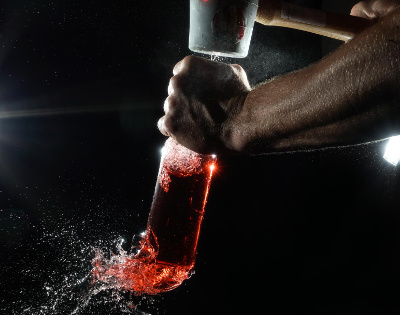
A more forceful demonstration of the "breaking bottle trick" using a rubber mallet.
(Utah State University image.)
The conventional way to quantify cavitation is by a variant of a
dimensionless parameter, called the
Euler number. While this cavitation number is good at predicting the onset of cavitation for
fluid flow, as around
propellers and in pumps, it doesn't accurately predict cavitation in sharply
accelerated liquids, as in the breaking bottle case.[4-5] says
Tadd Truscott, an
associate professor of
mechanical engineering at Utah State University and lead
author of the study,
"The traditional formula would tell us cavitation won't happen by smacking your palm against the top of a bottle... but experience tells us otherwise. The bottle will usually shatter, and now we have photographic evidence of cavitation bubbles forming in the bottle and their subsequent collapse and shockwaves. This tells us the conventional cavitation number doesn't always work correctly."[5]
The
research team proposed an alternative cavitation number that's better at predicting the onset of cavitation caused by a sudden acceleration rather than a large fluid
velocity.[4] This new cavitation number is based on acceleration and fluid depth, and not merely on velocity.[4] Cavitation breakage of dropped test tubes was analyzed using high-speed photography. When an empty
glass test tube was dropped from a 200
millimeter height onto the
floor, the impact with the floor did not break the glass when it was empty. However, when the tube was filled with
silicone oil, a cavitation bubble forms at t = 0.25 ms, and it collapses at 0.35 ms.
Fracture immediately develops at the location of the cavitation bubble collapse (see photos).[4]
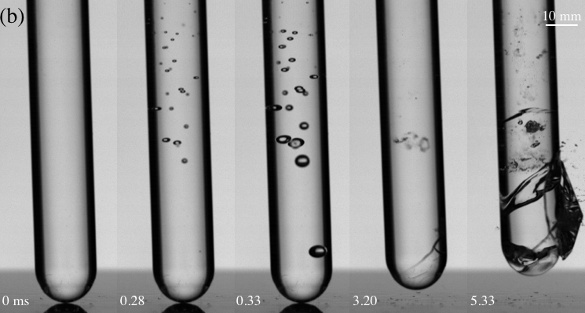
Cavitation by dropping a sealed test tube filled with silicone oil. Note that the drop, itself, doesn't break the tube; rather, the cavitation bubble formed at the inside surface does. (Utah State University image.)[4]
To validate this new number,
experiments were conducted to determine the threshold for cavitation in a variety of systems. Their new cavitation equation correctly determined the onset of cavitation.[5] This can have consequences beyond
engineered fluid systems, since some
brain injuries are the result of acceleration-induced cavitation.[5]
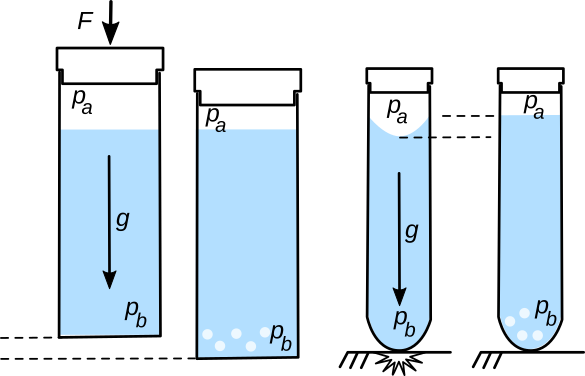
Two routes to cavitation by acceleration. Top impact (left) and bottom impact (right) give a change in the water column height. (Schematic based on fig. 2 of ref. 4.)[4]
References:
- L. Euler, "Théorie plus complette des machines qui sont mises en mouvement par la réaction de l'eau," (A more complete theory of machines that are set in motion by reaction with water), Mémoires de l'Académie Royale des Sciences et des Belles Lettres à Berlin, vol. 10 (1754), pp. 227-295 (via Google Books).
- Shengcai Li, Christopher E. Brennen, and Yoichiro Matsumoto, "Introduction for amazing (cavitation) bubbles," Interface Focus, vol. 5, no. 5 (October 6, 2015), DOI: 10.1098/rsfs.2015.0059.
- Lord Rayleigh, "On the pressure developed in a liquid during the collapse of a spherical cavity," Phil. Mag., vol. 34, no. 200 (1917), pp. 94-98, doi:10.1080/14786440808635681.
- Zhao Pan, Akihito Kiyama, Yoshiyuki Tagawa, David J. Daily, Scott L. Thomson, Randy Hurd, and Tadd T. Truscott, "Cavitation onset caused by acceleration," Proc, Natl. Acad. Sci., vol. 114, no. 32 (August 8, 2017), pp. 8470-8474, doi: 10.1073/pnas.1702502114. A PDF file of the paper can be found here.
- Splash Lab Develops New Math Equation to Predict Cavitation, Utah State University Press Release, July 24, 2017.
Linked Keywords: Liquid; gas; hardness; soft; material; steel; sensor; cavitation; hydraulic pump; mechanics; mechanical; bubble; pressure; implosion (mechanical process); implode; shock wave; impact (mechanics); metal; cyclic fatigue; tension; compression; ship propeller blade; centrifugal pump; impellers; pipe; cavitation; ship propeller; US National Park Service; phenomenon; Leonhard Euler (1707-1783); Great Britain; British; warship; HMS Daring (1893); wind tunnel; physics; John William Strutt, 3rd Baron Rayleigh; Rayleigh–Plesset equation; ordinary differential equation; dynamics; sphere; spherical; hemisphere; nucleation; nucleate; surface; transient; heating; focus; laser; pulse; electrical discharge; temperature; pressure; gas; kelvin; atmosphere; sonoluminescence; acoustics; acoustically; noble gas; saturation; saturated; light; temperature; excited state; Wikimedia Commons; Aolzick; YouTube; video; bottle; scientist; Utah State University (Logan, Utah); Tokyo University of Agriculture and Technology (Tokyo, Japan); Naval Undersea Warfare Center (Newport, Rhode Island); Brigham Young University (Provo, Utah); equation; experiment; experimental; Proceedings of the National Academy of Sciences; rubber; mallet; dimensionless; parameter; Euler number; fluid dynamics; fluid flow; propeller; acceleration; accelerated; Tadd Truscott; associate professor; mechanical engineering at Utah State University; author; formula; palm; photographic; research; velocity; glass; test tube; millimeter; floor; silicone oil; fracture; engineering; engineered; brain injury; impact; hydrostatic pressure; water column.